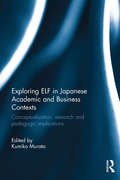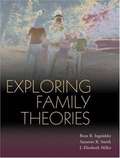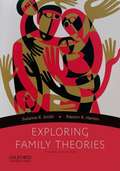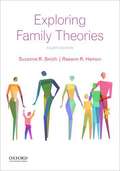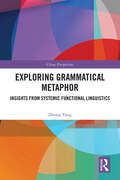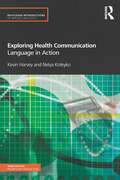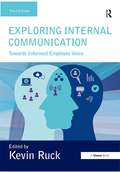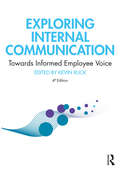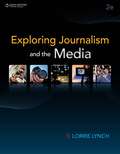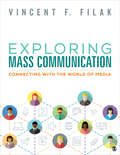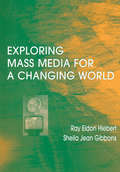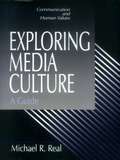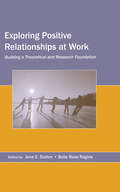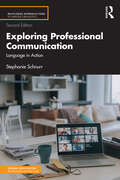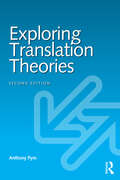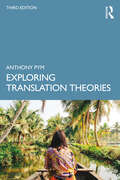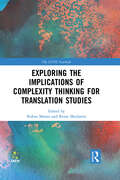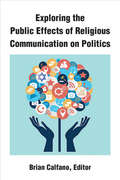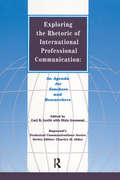- Table View
- List View
Exploring ELF in Japanese Academic and Business Contexts: Conceptualisation, research and pedagogic implications
by Kumiko MurataThis book investigates the theoretical, empirical and pedagogical issues to help us better understand what is happening with English as a Lingua Franca (ELF) communication and to activate this knowledge in respective communicative contexts. It focuses specifically on Japanese contexts and also includes theoretical and practical sections pertinent to all ELF researchers, practitioners and students, irrespective of their national or regional differences. It further attempts to connect this new field of research to established fields of linguistics and applied linguistics such as communication, assessment and multilingualism by exploring them from an ELF perspective, which is challenging but essential for the development of the field. Exploring ELF in Japanese Academic and Business Contexts: Conceptualisation, research and pedagogic implications includes chapters about: English in a Global Context Own-language use in academic discourse English as a lingua franca in international business contexts A linguistic soundscape/landscape analysis of ELF information provision in public transport in Tokyo Using pragmatic strategies for effective ELF communication: Relevance to classroom practice This book will be of interest to scholars and post-graduate students working in the fields of Applied Linguistics/TESOL. It will also engage researchers studying the growing influence of English around the world.
Exploring Family Theories
by Bron B. IngoldsbyThe purpose of this text is to provide a basic introduction to the major theories pertaining to the family among professionals today. Each addresses different aspects of family life and answers different questions. Humans are extremely complex, and it is difficult to analyze ourselves; therefore, every theory will be imperfect. But each one brings us closer to understanding and being able to make positive change where needed in family life. Each theory has its own basic assumptions and concepts, and is a product of its own historical context as well. Each is used in answering specific research questions that other theories may not answer, or may answer differently. It will be up to you to try on the lens of each theory and determine how well you think it explains human and family behavior.
Exploring Family Theories
by Suzanne R. Smith Raeann R. HamonOffering a diverse variety of perspectives, Exploring Family Theories, Third Edition, is a combined text/reader that integrates theory with research and applications. In each chapter, Suzanne R. Smith and Raeann R. Hamon present the history, scholarship, and critiques of one principal familytheory in a concise manner. Numerous examples and illustrations augment and clarify content, while application questions help students relate these theories to the real world. After each chapter, a follow-up journal article exemplifies how that particular theory is used to guide actual research.
Exploring Family Theories
by Suzanne R. Smith Raeann R. HamonOffering a diverse variety of perspectives, Exploring Family Theories, Fourth Edition, is a combined text/reader that integrates theory with research and applications. In each chapter, Suzanne R. Smith and Raeann R. Hamon present the history, scholarship, and critiques of one principal family theory in a concise manner. Numerous examples and illustrations augment and clarify content, while application questions help students relate these theories to the real world. After each chapter, a follow-up journal article exemplifies how that particular theory is used to guide actual research.
Exploring Grammatical Metaphor: Insights from Systemic Functional Linguistics (China Perspectives)
by Zhong YangThis book explores the fascinating world of grammatical metaphor through the lens of systemic functional linguistics. It provides a valuable toolkit for understanding how grammatical metaphor can expand the potential for meaning and serve as a key resource for bridging linguistic and cultural gaps in different contexts.Grammatical metaphor is presented not merely as a linguistic feature, but as a powerful tool that transforms meaning across grammatical categories. This book examines how this phenomenon of “transcategorisation” works, showing how it shifts and enriches the representation of meaning. Using the framework of systemic functional linguistics, the book emphasises the dynamic relationship between language systems and the texts they produce. Combining theory and practice, it investigates the wide-ranging applications of grammatical metaphor in fields such as contrastive linguistics, discourse analysis, and translation studies. Readers will discover how grammatical metaphor increases the flexibility and depth of language, enabling speakers and writers to achieve more nuanced and effective communication.This book will be essential reading for linguists, language learners, translators, and intercultural communicators. Whether you’re a researcher or a practitioner, this book will inspire new ways of thinking about language and communication.
Exploring Health Communication: Language in Action (Routledge Introductions to Applied Linguistics)
by Kevin Harvey Nelya KoteykoRoutledge Introductions to Applied Linguistics is a series of introductory level textbooks covering the core topics in Applied Linguistics, primarily designed for those beginning postgraduate studies, or taking an introductory MA course as well as advanced undergraduates. Titles in the series are also ideal for language professionals returning to academic study. The books take an innovative ‘practice to theory’ approach, with a 'back-to-front' structure. This leads the reader from real-world problems and issues, through a discussion of intervention and how to engage with these concerns, before finally relating these practical issues to theoretical foundations. Additional features include tasks with commentaries, a glossary of key terms, and an annotated further reading section. Exploring Health Communication brings together many of the various linguistic strands in health communication, while maintaining an interdisciplinary focus on method and theory. It critically explores and discusses a number of underlying themes that constitute the broad field of health communication including spoken, written and electronic health communication. The rise of the internet has led to an explosion of interactive online health resources which have profoundly affected the way in which healthcare is delivered, and with this, have brought about changes in the relationship between provider and patient. This textbook uses examples of real life health language data throughout, in order to fully explore the topics covered. Exploring Health Communication is essential reading for postgraduate and upper undergraduate students of applied linguistics and health communication.
Exploring Internal Communication: Towards Informed Employee Voice
by Kevin RuckThis third edition of Exploring Internal Communication includes new chapters on the history of internal communication, the evolution of employee engagement, the current state of practice, change communication, storytelling, research and measurement, an internal communication measurement dashboard, intranet management and internal social media. It argues that internal communication practice is about keeping employees informed and at the same time giving them a voice that is treated seriously. The book is both a companion for internal communication courses and an exploration of key concepts for a strategic approach to practice that underpins employee engagement.
Exploring Internal Communication: Towards Informed Employee Voice
by Kevin RuckExploring Internal Communication has long been the go-to publication for internal communication, public relations and human resources practitioners who want their practice to be grounded in research and guided by evidence-based advice. The new fourth edition has been comprehensively updated throughout to reflect the latest practices in internal communication. Notably, the use of social media within organisations is covered in recognition of the increasing integration of digital platforms such as Workplace by Facebook, Slack and Yammer. A greater understanding of the different communication roles played by line managers and senior managers is emerging, and this is explored to help those managers understand what is expected of them and how to succeed as they communicate within this changing environment. And, the demands of channel management are becoming increasingly complex; this edition helps practitioners negotiate this complexity. Enriched with models, tips and case studies, this book is an indispensable tool for both students and practitioners alike.
Exploring Journalism and the Media
by Lorrie LynchIntroduce your students to the exciting world of journalism using the hands-on, relevant approach of EXPLORING JOURNALISM AND THE MEDIA, 2e. The instructional model presents timeless concepts and applications that will prepare students for scholastic journalism, as well as lay the ground work for future classes, jobs, and careers. Author Lorrie Lynch's experience as a USA Today journalist gives a unique perspective absent from most other journalism textbooks. Profiles of real journalists, authentic student writings from scholastic publications, 21st Century Career Skills, and discussion on legal issues and editorial ethics will help students connect to the curriculum. EXPLORING JOURNALISM AND THE MEDIA, 2e will not only introduce students to the many different journalism career opportunities, but will also help them perform better in the classroom by providing academic connections, grammar tips, critical thinking activities, and writing activities.
Exploring Journalism and the Media
by Lorrie LynchIntroduce your students to the exciting world of journalism using the hands-on, relevant approach of EXPLORING JOURNALISM AND THE MEDIA, 2e. The instructional model presents timeless concepts and applications that will prepare students for scholastic journalism, as well as lay the ground work for future classes, jobs, and careers. Author Lorrie Lynch's experience as a USA Today journalist gives a unique perspective absent from most other journalism textbooks. Profiles of real journalists, authentic student writings from scholastic publications, 21st Century Career Skills, and discussion on legal issues and editorial ethics will help students connect to the curriculum. EXPLORING JOURNALISM AND THE MEDIA, 2e will not only introduce students to the many different journalism career opportunities, but will also help them perform better in the classroom by providing academic connections, grammar tips, critical thinking activities, and writing activities.
Exploring Mass Communication: Connecting with the World of Media
by Vincent F. FilakVincent F. Filak named next editor for Journalism and Mass Communication Educator Exploring Mass Communication examines the many paths that led to our digital media world and how digital media both connects and disconnects us. While providing the need-to-know concepts, history, and theories, Vincent F. Filak urges students to critically think about how media affects them, and how they can best engage with media to improve their everyday lives. Through Filak′s conversational and personable style, the text interweaves inclusivity and diversity throughout, presenting a modern and fresh approach that today’s students will connect with. This title is accompanied by a complete teaching and learning package. Learning Platform / Courseware Sage Vantage is an intuitive learning platform that integrates quality Sage textbook content with assignable multimedia activities and auto-graded assessments to drive student engagement and ensure accountability. Unparalleled in its ease of use and built for dynamic teaching and learning, Vantage offers customizable LMS integration and best-in-class support. It’s a learning platform you, and your students, will actually love.. Assignable Video with Assessment Assignable video (available in Sage Vantage) is tied to learning objectives and curated exclusively for this text to bring concepts to life. LMS Cartridge: Import this title’s instructor resources into your school’s learning management system (LMS) and save time. Don’t use an LMS? You can still access all of the same online resources for this title via the password-protected Instructor Resource Site.
Exploring Mass Communication: Connecting with the World of Media
by Vincent F. FilakVincent F. Filak named next editor for Journalism and Mass Communication Educator Exploring Mass Communication examines the many paths that led to our digital media world and how digital media both connects and disconnects us. While providing the need-to-know concepts, history, and theories, Vincent F. Filak urges students to critically think about how media affects them, and how they can best engage with media to improve their everyday lives. Through Filak′s conversational and personable style, the text interweaves inclusivity and diversity throughout, presenting a modern and fresh approach that today’s students will connect with. This title is accompanied by a complete teaching and learning package. Learning Platform / Courseware Sage Vantage is an intuitive learning platform that integrates quality Sage textbook content with assignable multimedia activities and auto-graded assessments to drive student engagement and ensure accountability. Unparalleled in its ease of use and built for dynamic teaching and learning, Vantage offers customizable LMS integration and best-in-class support. It’s a learning platform you, and your students, will actually love.. Assignable Video with Assessment Assignable video (available in Sage Vantage) is tied to learning objectives and curated exclusively for this text to bring concepts to life. LMS Cartridge: Import this title’s instructor resources into your school’s learning management system (LMS) and save time. Don’t use an LMS? You can still access all of the same online resources for this title via the password-protected Instructor Resource Site.
Exploring Mass Media for A Changing World: Instructor's Manual: Cases For Reflection And Action
by Ray A Hiebert Sheila GibbonsBeautifully written and class tested, Exploring Mass Media for a Changing World provides a comprehensive but modestly priced text around which instructors can develop a customized teaching package. Written for introductory courses, it covers essential information students need in order to understand the media, the mass communication process, and the role of media in society. It summarizes basic, generally agreed-upon principles, theories, significant historical events, and essential facts, but does so in a tightly written, readable style. Taken together, this information can be thought of as a minimum repertoire that all citizens of the "information age" need in order to become literate consumers and users of mass communication. Features include: *Historical Framework--For ease of comprehension, media processes and individual media are placed in historical context to show their technological evolution and the effects of those changes on society. *Organization--The first seven chapters deal with the evolution of communication theories and processes common to all media. The next five deal with specific media in the chronological order in which they became mass media. Chapters 13 and 14 introduce two non-media institutions (advertising and public relations) whose exploration is essential in order to understand how mass media functions in our society. Finally, chapter 15 returns to the theme of technological evolution and its effects on society with an in-depth discussion of the internet. *Flexibility--Because it is concise, affordable, and comprehensive, it can be used either as a stand-alone text in mass media courses or as part of an instructional package in courses where mass communication is one of several major units. *Themes--The following themes are introduced early and carried throughout: (a) the evolution of media technology and its effects on society, (b) the global and culture-bound characteristics of mass media, and (c) the need for media literacy in the 21st century. *Supplements--An accompanying instructor's manual begins with a chapter-length essay on teaching the mass media course then offers the following items for each chapter: topical outline and key vocabulary; key ideas to be emphasized and pitfalls to be avoided; discussion questions; objective and essay test items; and both print and nonprint resources for further study.
Exploring Media Culture: A Guide (Communication and Human Values)
by Michael RealThis unique textbook provides a fresh interpretation of media analysis and cultural studies. Each chapter focuses on a particular aspect of American popular culture - including Hollywood cinema, presidential elections and the Super Bowl - to demystify complex concepts such as ritual, postmodernism and political economy. This use of popular culture texts, narratives and interpretations will enable readers to understand more about this important yet esoteric debate. Exploring Media Culture synthesizes a wealth of information and research and presents this in an engaging and accessible format.
Exploring Positive Relationships at Work: Building a Theoretical and Research Foundation (Organization and Management Series)
by Building A TheoreticalThis edited volume brings together a select group of leading organizational scholars for the purpose of developing a foundation-setting book on positive relationships at work. Positive Relationships at Work (PRW) is a rich new interdisciplinary domain of inquiry that focuses on the generative processes, relational mechanisms and outcomes associated with positive relationships between people at work. This volume builds a solid foundation for this promising new area of scholarly inquiry and offers a multidisciplinary exploration of how relationships at work become a source of growth, vitality, learning and generative states of human and collective flourishing. A unique feature of the book is the use of a connecting commentator chapter at the end of each section. The Commentator Chapters, written by preeminent scholars, uncover and discuss integrative themes that emerge within sections. The editors approach the topic from multiple levels, each level providing critical, valuable insights into the dynamic process underlying positive relationships at work. These levels are arranged in five parts: an introduction to positive relationships at work; Individuals and Dyads; Groups and Communities; Organizations and Organizing; and a conclusion that offers an engaging invitation and multi-level map for guiding future research. This volume will appeal to academics and practitioners, as well as scholars and graduate students in organizational psychology, management, human resources, and inter-personal communications.
Exploring Professional Communication: Language in Action (Routledge Introductions to Applied Linguistics)
by Stephanie SchnurrRoutledge Introductions to Applied Linguistics is a series of introductory level textbooks covering the core topics in Applied Linguistics, primarily designed for those beginning postgraduate studies, or taking an introductory MA course as well as advanced undergraduates. Titles in the series are also ideal for language professionals returning to academic study. The books take an innovative ‘practice-to-theory’ approach, with a 'back-to-front' structure. This leads the reader from real-world problems and issues, through a discussion of intervention and how to engage with these concerns, before finally relating these practical issues to theoretical foundations. Additional features include tasks with commentaries, a glossary of key terms, and an annotated further reading section. Exploring Professional Communication provides an accessible overview of the vast field of communication in professional contexts from an applied linguistics perspective. It explores the nature of professional communication by discussing various fundamental topics relevant for an understanding of this area. The book is divided into eight chapters, each dealing with a specific area of professional communication, such as genres of professional communication, identities in the workplace, and key issues of gender, leadership and culture. Although the book’s main approach to professional communication is an applied linguistics one, it also draws on insights from a range of other disciplines. Throughout, Stephanie Schnurr takes an interactive approach that is reflected in the numerous examples of authentic discourse data, from a variety of written and spoken contexts. Exploring Professional Communication is critical reading for postgraduate and upper undergraduate students of applied linguistics and communication studies.
Exploring Professional Communication: Language in Action (Routledge Introductions to Applied Linguistics)
by Stephanie SchnurrRoutledge Introductions to Applied Linguistics is a series of introductory level textbooks covering the core topics in applied linguistics, primarily designed for those beginning postgraduate studies, or taking an introductory MA course, as well as for advanced undergraduates. Titles in the series are also ideal for language professionals returning to academic study. The books take an innovative ‘practice-to-theory’ approach, with a ‘back-to-front’ structure. This leads the reader from real-world problems and issues, through a discussion of intervention and how to engage with these concerns, before finally relating these practical issues to theoretical foundations. Additional features include tasks with commentaries, a glossary of key terms and an annotated further reading section. Exploring Professional Communication provides an accessible overview of the vast field of communication in professional contexts from an applied linguistics perspective. It explores the nature of professional communication by discussing various fundamental topics relevant for an understanding of this area. The book is divided into eight chapters, each dealing with a specific area of professional communication, such as genres of professional communication, identities in the workplace and key issues of gender, leadership and culture. Although the book’s main approach to professional communication is an applied linguistics one, it also draws on insights from a range of other disciplines. This second edition has been substantially revised and updated and includes coverage of the most recent developments in the area. New topics include: Remote and virtual communication, as well as technology-assisted communication The impact of the pandemic on professional communication Gender in professional communication post-#metoo Intersectional issues A new chapter on researching professional communication Throughout, Stephanie Schnurr takes an interactive approach that is reflected in the numerous examples of authentic discourse data, from a variety of written, spoken and multimodal contexts. Exploring Professional Communication is critical reading for postgraduate and upper undergraduate students of applied linguistics and communication studies.
Exploring Science Communication: A Science and Technology Studies Approach
by Ulrike Felt Sarah R. DaviesExploring Science Communication demonstrates how science and technology studies approaches can be explicitly integrated into effective, powerful science communication research. Through a range of case studies, from climate change and public parks to Facebook, museums, and media coverage, it helps you to understand and analyse the complex and diverse ways science and society relate in today’s knowledge intensive environments. Notable features include: A focus on showing how to bring academic STS theory into your own science communication research Coverage of a range of topics and case studies illustrating different analyses and approaches Speaks to disciplines across Media & Communication, Science & Technology Studies, Health Sciences, Environmental Sciences and related areas. With this book you will learn how science communication can be more than just about disseminating facts to the public, but actually generative, leading to new understanding, research, and practices.
Exploring Science Communication: A Science and Technology Studies Approach
by Ulrike Felt Sarah R. DaviesExploring Science Communication demonstrates how science and technology studies approaches can be explicitly integrated into effective, powerful science communication research. Through a range of case studies, from climate change and public parks to Facebook, museums, and media coverage, it helps you to understand and analyse the complex and diverse ways science and society relate in today’s knowledge intensive environments. Notable features include: A focus on showing how to bring academic STS theory into your own science communication research Coverage of a range of topics and case studies illustrating different analyses and approaches Speaks to disciplines across Media & Communication, Science & Technology Studies, Health Sciences, Environmental Sciences and related areas. With this book you will learn how science communication can be more than just about disseminating facts to the public, but actually generative, leading to new understanding, research, and practices.
Exploring Translation Theories
by Anthony PymExploring Translation Theories presents a comprehensive analysis of the core contemporary paradigms of Western translation theory. The book covers theories of equivalence, purpose, description, uncertainty, localization, and cultural translation. This second edition adds coverage on new translation technologies, volunteer translators, non-lineal logic, mediation, Asian languages, and research on translators’ cognitive processes. Readers are encouraged to explore the various theories and consider their strengths, weaknesses, and implications for translation practice. The book concludes with a survey of the way translation is used as a model in postmodern cultural studies and sociologies, extending its scope beyond traditional Western notions. Features in each chapter include: An introduction outlining the main points, key concepts and illustrative examples. Examples drawn from a range of languages, although knowledge of no language other than English is assumed. Discussion points and suggested classroom activities. A chapter summary. This comprehensive and engaging book is ideal both for self-study and as a textbook for Translation theory courses within Translation Studies, Comparative Literature and Applied Linguistics.
Exploring Translation Theories
by Anthony PymExploring Translation Theories presents a comprehensive analysis of the core contemporary paradigms of Western translation theory. This engaging overview covers the key theories of equivalence, solution types, purpose, scientific approaches, uncertainty, automation, and cultural translation. Fully revised, this third edition adds coverage of Russian and Ukrainian theories, examples from Chinese, advances in machine translation, and research on translators’ cognitive processes. Readers are encouraged to explore the various theories and consider their strengths, weaknesses, and implications for translation practice. The book concludes with a survey of the way translation is used as a model in postmodern cultural studies and sociologies, extending its scope beyond traditional Western notions. Features in each chapter include: An introduction outlining the main points, key concepts and illustrative examples. Examples drawn from a range of languages, although knowledge of no language other than English is assumed. Discussion points and suggested classroom activities. A chapter summary. This comprehensive and engaging book is ideal both for self-study and as a textbook for Translation theory courses within Translation Studies, Comparative Literature and Applied Linguistics.
Exploring the DataFlow Supercomputing Paradigm: Example Algorithms for Selected Applications (Computer Communications and Networks)
by Veljko Milutinovic Milos KotlarThis useful text/reference describes the implementation of a varied selection of algorithms in the DataFlow paradigm, highlighting the exciting potential of DataFlow computing for applications in such areas as image understanding, biomedicine, physics simulation, and business.The mapping of additional algorithms onto the DataFlow architecture is also covered in the following Springer titles from the same team: DataFlow Supercomputing Essentials: Research, Development and Education, DataFlow Supercomputing Essentials: Algorithms, Applications and Implementations, and Guide to DataFlow Supercomputing.Topics and Features: introduces a novel method of graph partitioning for large graphs involving the construction of a skeleton graph; describes a cloud-supported web-based integrated development environment that can develop and run programs without DataFlow hardware owned by the user; showcases a new approach for the calculation of the extrema of functions in one dimension, by implementing the Golden Section Search algorithm; reviews algorithms for a DataFlow architecture that uses matrices and vectors as the underlying data structure; presents an algorithm for spherical code design, based on the variable repulsion force method; discusses the implementation of a face recognition application, using the DataFlow paradigm; proposes a method for region of interest-based image segmentation of mammogram images on high-performance reconfigurable DataFlow computers; surveys a diverse range of DataFlow applications in physics simulations, and investigates a DataFlow implementation of a Bitcoin mining algorithm.This unique volume will prove a valuable reference for researchers and programmers of DataFlow computing, and supercomputing in general. Graduate and advanced undergraduate students will also find that the book serves as an ideal supplementary text for courses on Data Mining, Microprocessor Systems, and VLSI Systems.
Exploring the Implications of Complexity Thinking for Translation Studies (The IATIS Yearbook)
by Kobus MaraisExploring the Implications of Complexity Thinking for Translation Studies considers the new link between translation studies and complexity thinking. Edited by leading scholars in this emerging field, the collection builds on and expands work done in complexity thinking in translation studies over the past decade. In this volume, the contributors address a variety of implications that this new approach holds for key concepts in Translation Studies such as source vs. target texts, translational units, authorship, translatorship, for research topics including translation data, machine translation, communities of practice, and for research methods such as constraints and the emergence of trajectories. The various chapters provide valuable information as to how research methods informed by complexity thinking can be applied in translation studies. Presenting theoretical and methodological contributions as well as case studies, this volume is of interest to advanced students, academics, and researchers in translation and interpreting studies, literary studies, and related areas.
Exploring the Public Effects of Religious Communication on Politics
by Brian CalfanoThough not all people are religious believers, religion has played important historic roles in developing political systems, parties, and policies—affecting believers and nonbelievers alike. This is particularly true in the United States, where scholars have devoted considerable attention to a variety of political phenomena at the intersection of religious belief and identity, including social movements, voting behavior, public opinion, and public policy. These outcomes are motivated by “identity boundary-making” among the religiously affiliated. The contributors to this volume examine two main factors that influence religious identity: the communication of religious ideas and the perceptions of people (including elites) in communicating said ideas. Exploring the Public Effects of Religious Communication on Politics examines an array of religious communication phenomena. These include the media’s role in furthering religious narratives about minority groups, religious strategies that interest groups use to advance their appeal, the variable strength of Islamophobia in cross-national contexts, what qualifies as an “evangelical” identity, and clergy representation of religious and institutional teachings. The volume also provides ways for readers to think about developing new insights into the influence religious communication has on political outcomes.
Exploring the Rhetoric of International Professional Communication: An Agenda for Teachers and Researchers (Baywood's Technical Communications)
by Carl R. Lovitt Dixie GoswamiPresents a collection of fourteen essays that responds to the need for a more rhetorical conception of professional communication as an international discipline. This book challenges the adequacy of relying on preconceived notions about the factors that determine discourse in international professional settings.
